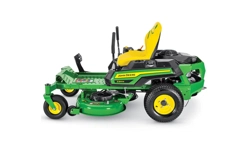Loading ...
Loading ...
Loading ...

GX100111—UN—19FEB20
● Attachments such as material collection systems, weather
enclosures, or other attachments increase the risk of a rollover.
When using attachments, never mow or operate this ride-on mower
on slope angles greater than 10°. (A 10° slope is a slope that rises 1
m [3.5 ft] over a horizontal distance of 6.1 m [20 ft].)
● The risk of rollover is low on slopes of 10° or less. As the slope
angle increases to the recommended maximum, the risk increases
to a medium level.
Operating Near Terrain Hazards
GX100105—UN—01FEB20
● Terrain hazards such as ditches and drop offs are a factor related to
loss-of-control and tip-over accidents, which can result in serious
injury or death. Use caution and common sense when operating
near terrain hazards.
● Do not mow or operate the machine in areas adjacent to hazards
that can cause the machine to roll over. If a wheel goes over an
edge or if the edge breaks away, the machine can suddenly lose
traction, slide, and/or roll over.
● Hazards (A) include but are not limited to ditches, drop-offs,
embankments, or areas near bodies of water.
● Maintain a buffer area (B) at least as wide as the machine between
hazards (A) and the mowing area (C). Do not mow or operate the
machine in the hazard area or buffer area.
● Only mow or operate in the mowing area (C). Do not exceed the
recommended slope operating angle. Refer to the Slope Limits
section.
OUO2005,000078A-19-09MAR20
Prevent Fires
TS227—UN—15APR13
● Do not mow tall, dry grass or through piles of leaves. Combustible
materials can contact hot components and increase the risk of re.
● Debris can build up anywhere on the machine, especially on
horizontal surfaces. While using your machine, periodically check
for and remove debris, especially in dry or heavy debris conditions,
such as when collecting leaves.
● After operating, completely remove any combustible materials from
equipment before storing. Use compressed air, a leaf blower, or
water to keep the machine clean.
● Allow machine to cool in an open area before storing. Do not park
machine near ammable materials, such as straw, mulch, cloth, or
chemicals. Do not park near an open ame or other sources of
ignition, such as a water heater or furnace.
● Excess lubrication or fuel/oil leaks or spills on the machine can also
provide collection sites for debris. Promptly cleaning up spills and
repairing leaks reduces the potential for debris collection.
● Refer to the Machine Cleanout section for more information on
checking for debris buildup and locations to inspect.
● Always park the machine safely before cleaning or servicing a
machine. See the Parking Safely section.
OUO2005,0000787-19-15FEB20
Parking Safely
Always apply the park brake and remove the key before leaving the
machine unattended. Children or others may attempt to move or
operate an unattended machine.
● Stop the machine on a level surface.
● Disengage mower blades or other attachments.
● Lower attachments to the ground.
● Apply the park brake.
● Stop the engine.
● Remove the key.
● Wait for engine and all moving parts to stop before you leave the
seat.
OUO2005,0000788-19-15FEB20
Safety
11
Loading ...
Loading ...
Loading ...
